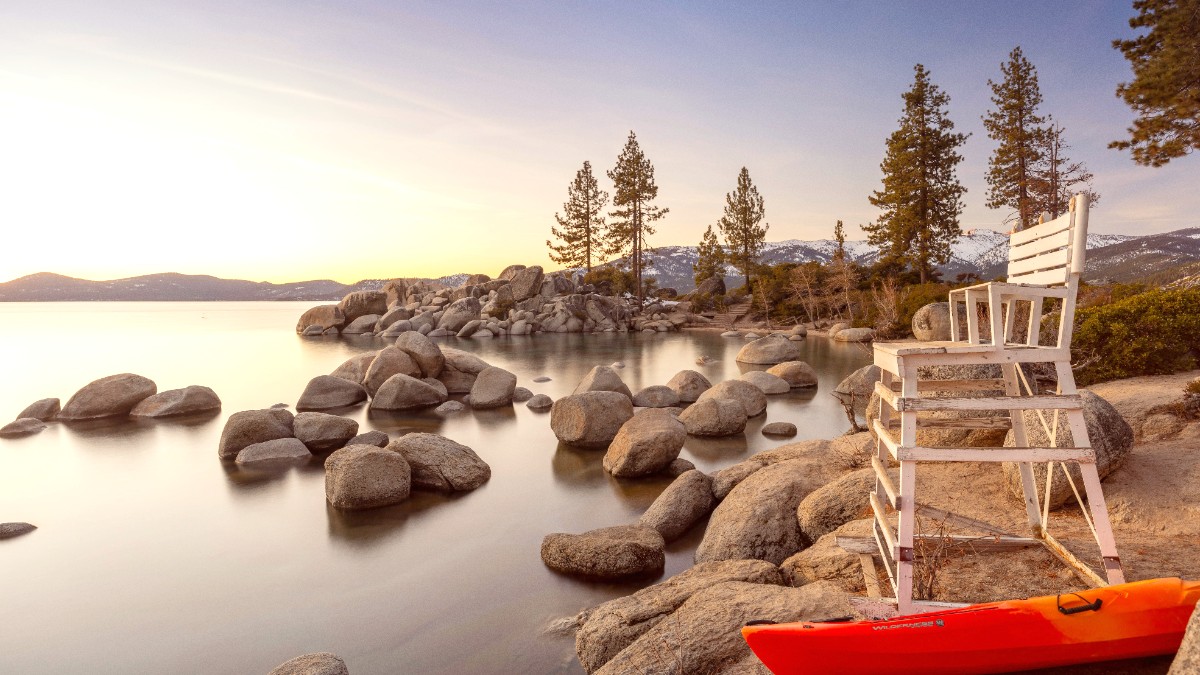
Nevada, USA
The lake divides between two states. Approximately two-thirds of the shoreline lies in California, while the remaining third is in Nevada. Distinct towns dot the shoreline, each with its own character. South Lake Tahoe, California, and Stateline, Nevada, form a bustling hub with casinos and resorts on the southern end. As you move north, you find Tahoe City and Kings Beach in California, offering a more relaxed, historic feel. Incline Village on the Nevada side offers an upscale setting. Truckee, a historic railroad town, sits just outside the Tahoe Basin, providing another entry point to the region's charm.
Mountains surround the lake, with peaks like Mount Tallac and Freel Peak rising high above the water. These mountains form a dramatic backdrop and offer many trails for exploration. The crystal-clear water of Lake Tahoe is famous. Its clarity comes from the purity of the snowmelt and rain that feeds it, along with a lack of sediment.
The ecosystem here is delicate. Efforts focus on preserving the clarity of the water and the health of the surrounding forests. You find unique flora and fauna in the area, including the native Lahontan cutthroat trout (though fishing for native species is restricted). The high elevation influences weather patterns, creating distinct seasons with warm, dry summers and cold, snowy winters. This makes Lake Tahoe a year-round destination, with summer lake activities and winter snow sports.
Lake Tahoe's history stretches back thousands of years. The Washoe Tribe lived in the Tahoe Basin for at least 6,000 years, possibly longer. They knew the lake as "Da ow a ga," meaning "The Edge of the Lake." The Washoe people moved seasonally, using the lake and surrounding mountains for hunting, fishing, and gathering. Their culture revolved around the land, and they lived in harmony with its rhythms. Evidence of their presence, like petroglyphs and grinding stones, remains in certain areas. Treat these sites with respect.
European explorers arrived in the early 19th century. John C. Frémont, an American explorer, first mapped the lake in 1844, calling it "Mountain Lake." Later, it gained the name "Lake Bigler" after a California governor. The name "Tahoe" came about in the 1860s, a mispronunciation of the Washoe word "Da ow." This name caught on, eventually becoming the official designation. The California Gold Rush and Nevada's Comstock Lode in the mid-19th century brought rapid changes. Miners, loggers, and opportunists flocked to the region. Railroads arrived, connecting the remote Sierra Nevada to the growing West. This period saw heavy deforestation and changes to the landscape.
6,000+ years of seasonal living and cultural connection to the land.
John C. Frémont maps the lake, initially calling it "Mountain Lake."
Rapid development, logging, and railroad expansion impact the region.
Wealthy families build grand estates like Vikingsholm Castle.
Tahoe transforms into a winter sports mecca and entertainment hub, with the 1960 Winter Olympics at Squaw Valley.
Over time, concern grew for the lake's clarity, impacted by development and pollution. The "Keep Tahoe Blue" movement began in the 1960s, leading to the creation of the Tahoe Regional Planning Agency (TRPA) in 1969. This bi-state agency works to protect the lake's environment and regulate growth, helping to preserve its beauty for future generations.
Vikingsholm Castle and the Tallac Historic Site are examples of this era's opulent architecture. These estates offered a retreat from city life, with boat houses, tennis courts, and lavish gardens, showing a period of grand leisure.
The 1960 Winter Olympics at Squaw Valley (now Palisades Tahoe) solidified Lake Tahoe's status as a world-class ski destination, drawing international attention to its slopes and winter activities.
This dual development—natural beauty and entertainment—defines Lake Tahoe's modern identity.
Lake Tahoe presents experiences for every type of traveler, regardless of their interests or the season. Imagine waking to the crisp mountain air, the sun rising over the clear, blue lake. You could spend your morning hiking a forested trail, leading to a secluded viewpoint. Perhaps you prefer to glide across the calm water in a kayak, or paddleboard with views of granite peaks reflected on the surface. Afternoons can involve relaxing on a sandy beach, swimming in the refreshing (though cool) water, or exploring charming lakeside towns with unique shops and local eateries.
In winter, the landscape transforms into a snowy wonderland. World-class ski resorts like Heavenly, Palisades Tahoe, and Northstar offer endless slopes for skiing and snowboarding, from gentle beginner runs to challenging expert terrain. You find opportunities for snowshoeing, cross-country skiing, and tubing. Cozy up by a fireplace in a mountain lodge after a day on the slopes, or enjoy apres-ski activities. Entertainment options include live music, outdoor concerts in summer, and the excitement of casino nightlife on the Nevada side. The area presents a perfect blend of natural beauty and organized recreation.
Hiking, kayaking, paddleboarding, and swimming in crystal-clear waters.
World-class skiing, snowboarding, snowshoeing, and cozy lodge experiences.
Emerald Bay State Park, Sand Harbor, and scenic mountain vistas.
Beyond the lake, the surrounding Sierra Nevada mountains present a vast playground for hiking, mountain biking, and wildlife viewing. Keep an eye out for black bears, deer, and many bird species. The region also hosts various events and festivals throughout the year, from food and wine gatherings to music festivals and cultural celebrations.